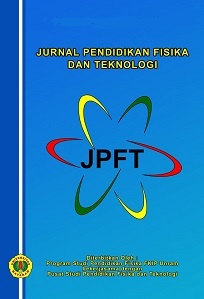Pengaruh Model Pemecahan Masalah Polya Berbantuan LKPD Terhadap Kemampuan Menganalisis Materi Fisika Peserta Didik SMAN 1 Selong Tahun Pelajaran 2016/2017
DOI:
10.29303/jpft.v3i2.366Published:
2017-12-03Issue:
Vol. 3 No. 2 (2017): Juli - DesemberKeywords:
Problem Solving, Polya Model, LKPD, Ability to AnalyzeArticles
Downloads
How to Cite
Downloads
Metrics
Abstract
This study aims to determine the effect of problem solving Polya model assisted by LKPD on the ability to analyze the physics of students. Type of this research is quasi experimental with research design untreated control group design with pre-test and post-test. The population is all students of class X. Samples are taken by using purposive sampling technique, so that the class X of MS 1 as experiment class and class X MS 2 as the control class. The analytical ability is measured by a written test in the form of a description. Based on the research result, the average value of the ability to analyze the experimental class students is 60,16 while the mean of the ability to analyze the control class is 41,53. The data capability of analyzing both classes is normally distributed and both homogeneous. Based on the test of hypothesis test-t polled variance, obtained tcount of 3.681. The ttable value for the data analysis ability of 1.996, at a significant level of 5%. The value of tcount is greater than ttable, meaning that there is influence of problem solving Ploya model with LKPD help on the ability of analyzing the physics of the students.References
Anderson & Krathwol. 2010. Kerangka Landasan untuk Pembelajaran Pengajaran dan Asesmen Revisi Taksonomi Pendidikan Bloom (terjemahan). Jakarta: Pustaka Belajar.
Aji, N.S. & Widodo. 2017. Pengembangan LKS Gerak Harmonik Sederhana dengan Media virtual laboratory Berbasis Problem Based Instruction. Jurnal Penelitian Pembelajaran Fisika. 8(1) 44-50.
Ekasari, R. R., Gunawan, G., Sahidu, H. 2016. Pengaruh Model Pembelajaran Langsung Berbantuan Media Laboratorium terhadap Kreatifitas Fisika Siswa SMA. Jurnal Pendidikan Fisika dan Teknologi, 1(3), 106-107.
Fitriyati, Kurniawan, E. S., & Ngazizah, N. (2013). Pengembangan LKS Fisika SMA Kelas X Semester II dengan Website Online Berbasis Contextual Teaching Learning. Jurnal Pendidikan Fisika Radiasi, 3(1), 7-11.
Hadi, S., Radiyatul. 2014. Metode Pemecahan Masalah Menurut Polya untuk Mengembangkan Kemampuan Siswa dalam Pemecahan Masalah Matematis. Jurnal Pendidikan Matematika, 2(1), 53-61.
Gunawan, G., Harjono, A., & Sahidu, H. 2015. Studi Pendahuluan pada Upaya Pengembangan Laboratorium Virtual bagi Calon Guru Fisika. Jurnal Pendidikan Fisika dan Teknologi, 1(2), 140-145.
Ikhwanuddin, Jaedun, A.,& Purwantoro, D. 2010. Problem Solving dalam Pembelajaran Fisika untuk Meningkatkan Kemampuan Mahasiswa Berpikir Analitis. Jurnal Kependidikan, 40(2), 215-230.
Jiniarti, B. E., Sahidu, H.,& Verawati, S. P. 2015. Implementasi Model Problem Based Learning berbantuan Alat Peraga untuk Meningkatkan Aktivitas dan Hasil Belajar Fisika Siswa Kelas VIII SMPN 22 Mataram Tahun Pelajaran 2014/2015. Jurnal Pendidikan Fisika dan Teknologi, 1(3), 185-192.
Komariah, K. 2011. Penerapan Metode Pembelajaran Problem Solving Model Polya untuk Meningkatkan Kemampuan Memecahkan Masalah Bagi Siswa Kelas IX J di SMPN 3 Cimahi. Prosiding Seminar Nasional Penelitian, Pendidikan dan Penerapan MIPA Fakultas MIPA UN, 181-217.
Maghfiroh, U., Sugianto. 2011. Penerapan Pembelajaran Fisika Bervisi Sets untuk Meningkatkan Kemampuan Berpikir Analitis Peserta Didik Kelas X. Jurnal Pendidikan Indonesia, 6-12.
Nurliawaty, L., Mujasam, Yusuf, I., & Widyaningsih, SW. 2017. Pengembangan Lembar Kerja Peserta Didik (LKPD) berbasis pemecahan masalah Polya pada Materi Kalor. Jurnal Pendidikan Indonesia, 6(1), 72-81.
Nurqomariah, Gunawan, &Sutrio. 2015. Pengaruh Model Problem Based Learning dengan Metode Eksperimen terhadap Hasil Belajar IPA Fisika Siswa Kelas VII SMP Negeri 19 Mataram Tahun Pelajaran 2014/2015. Jurnal Pendidikan Fisika dan Teknologi, 1(3), 173-178.
Purwanto, A. 2012. Kemampuan Berpikir Logis Siswa SMA Negeri 8 Kota Bengkulu dengan Meneerapkan Model Inkuiri Terbimbing dalam Pembelejaran Fisika. Jurnal Exacta, 10(2), 133-135.
Rofiah, E., Aminah, N. S., & Ekawati, E. Y. 2013. Penyusunan Instrumen Tes Kemampuan Berpikir Tingkat Tinggi Fisika pada Siswa SMP. Jurnal Pendidikan Fisika, 1(2), 17-22.
Sugiyono. 2015. Statistika untuk Penelitian. Bandung: Alfabeta.
Venisari, R., Gunawan,& Sutrio. 2015. Penerapan Metode Mind Mapping pada Model Direct Instruction untuk Meningkatkan Kemampuan Pemecahan Masalah Fisika Siswa SMPN 16 Mataram. Jurnal Pendidikan Fisika dan Teknologi, 1(3), 193-198.
Wena, M. 2014. Strategi Pembelajaran Inovatif Kontemporer Suatu Tinjauan Konseptual Operasional. Jakarta: Bumi Aksara.
Winarti. 2015. Profil Kemampuan Berpikir Analisis dan Evaluasi Mahasiswa dalam Mengerjakan Soal Konsep Kalor. Jurnal Inovasi dan Pembelajaran Fisika, 2(1), 19-24.
License
Authors who publish with Jurnal Pendidikan Fisika dan Teknologi (JPFT) agree to the following terms:
- Authors retain copyright and grant the journal right of first publication with the work simultaneously licensed under a Creative Commons Attribution License 4.0 International License (CC-BY-SA License). This license allows authors to use all articles, data sets, graphics, and appendices in data mining applications, search engines, web sites, blogs, and other platforms by providing an appropriate reference. The journal allows the author(s) to hold the copyright without restrictions and will retain publishing rights without restrictions.
- Authors are able to enter into separate, additional contractual arrangements for the non-exclusive distribution of the journal's published version of the work (e.g., post it to an institutional repository or publish it in a book), with an acknowledgement of its initial publication in Jurnal Pendidikan Fisika dan Teknologi (JPFT).
- Authors are permitted and encouraged to post their work online (e.g., in institutional repositories or on their website) prior to and during the submission process, as it can lead to productive exchanges, as well as earlier and greater citation of published work (See The Effect of Open Access).











